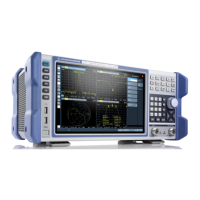Command reference
R&S
®
ZNL/ZNLE
699User Manual 1178.5966.02 ─ 20
They are only available, if a search mode is active for the respective marker (see
CALCulate<Chn>:MARKer<Mk>:FUNCtion:EXECute <SearchMode> or
CALCulate<Chn>:MARKer<Mk>:REFerence:FUNCtion:EXECute <Search
Mode>), in which case tracking causes the search logic to be repeated after each
sweep.
Tip: If the current search mode is a bandfilter or multiple peak search (regular markers
only), this command enables or disables the corresponding tracking.
Suffix:
<Chn>
.
Channel number used to identify the active trace
<Mk> Marker number
Ignored not only for reference markers, but also for bandfilter
and multiple peak searches, where tracking recalculates the
whole marker set for each sweep.
Parameters:
<Boolean> ON | OFF - enables or disables the marker tracking mode.
*RST: OFF
Example: Suppose the active channel setup contains an active trace no. 1.
CALC:MARK ON; :CALC:MARK:FUNC:EXEC MAXimum
Create marker no. 1 and assign it to trace no. 1. Activate a maxi-
mum search for marker no. 1.
CALC:MARK:SEAR:TRAC ON
Enable the tracking mode for the created marker.
Manual operation: See "Tracking" on page 460
CALCulate<Chn>:MARKer<Mk>[:STATe] <Boolean>
CALCulate<Chn>:MARKer<Mk>:REFerence[:STATe] <Boolean>
Creates or removes the related marker (see "Marker addressing" on page 681).
Suffix:
<Chn>
.
Channel number used to identify the active trace
<Mk> Marker number (ignored for reference markers)
Parameters:
<Boolean> ON | OFF – creates or removes the marker.
*RST: OFF
Example: Suppose that the active channel setup contains an active trace
no. 1.
CALC:MARK ON; MARK2 ON
Create markers 1 and 2 and assign them to trace no. 1. The
default position of both markers is the center of the sweep
range.
Manual operation: See "On" on page 450
VNA command reference

